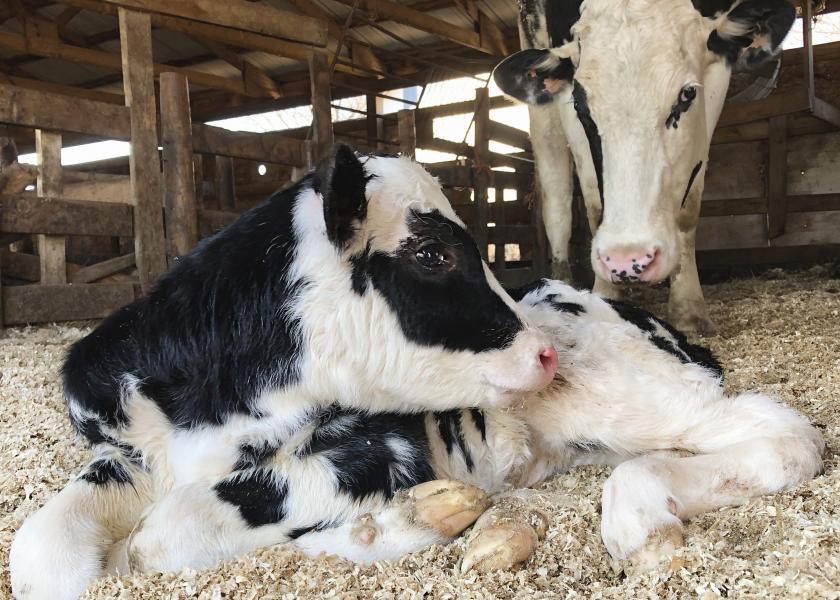Colostrum Comes First

Every winter I receive calls about calves doing poorly or dying from scours. This winter was no exception and might be one of the worst winters for young calves in the recent past.
Invariably the problem traces back to a poor start in life by not providing the proper nutrition and care of the calf from day one and maybe even before the calf is born. In some cases, colostrum feeding from the cow is being replaced by commercial colostrum replacers or even by pooled waste milk. The goal of a well-managed calf raising program is to produce a quality heifer and to maximize profits for the dairy farm.
Correctly feeding quality colostrum far outweighs any colostrum replacer, supplements, medicines or vaccines you can give the newborn calf. In most of these situations where calves were dying, the calf raisers were looking for an easy fix off the shelf rather than the real management issue.
There are three major areas to look at for management of a colostrum program. First of all, the quality of the colostrum is enhanced by correctly feeding the pregnant cow and giving the proper vaccines. Secondly, the colostrum must be harvested correctly, and lastly the calf has to receive the proper amount of colostrum at the proper time.
MOST NUTRITIOUS FOOD
The dam of the newborn calf makes the most nutritious food for the newborn calf, balanced with energy, nutrients and immunoglobulins, all perfectly suited for your specific farm. To produce quality colostrum, the cow needs a balanced diet in both energy and nutrients. The vaccination program designed for your herd sets the cow up for making the colostrum to fit the environment on your dairy. Even first-calf heifers can produce quality colostrum to use on calves.
Colostrum contains much more than only immunoglobulins (Igg). There are many other benefits to the calf contained in fresh colostrum, including glucose for energy, vitamins and minerals for strength and vitality, and several hormones including insulin, prolactin and growth hormone. These items altogether promote growth in the calf and provide a strong barrier to infection in the newborn dairy calf.
Colostrum is the communication tool from the cow to the calf to allow the calf to transition from the uterus to life on the ground. If properly fed, these benefits from the dam to the calf can extend out three to four days if there is enough colostrum to feed and the management to allow it to happen.
CLEAN, TIMELY HARVEST
Proper harvesting of the colostrum is crucial for the optimal transfer of this protection. The two most critical areas are timeliness and cleanliness. The calf should be separated from the cow as soon as possible after licking and drying the calf. I recommend a hay rack pen so the cow can lick the calf, but the calf cannot get up and attempt to nurse the cow. Both the cow and calf have processes that begin when the calf first nurses the cow and sets things in motion.
It is best to milk the cow within 3 hours of freshening and to feed the calf within the same time frame. Not allowing the calf to have access to the cow allows more time to milk the cow and feed the calf. The entire process must be done with clean equipment. Colostrum storage is best in a refrigerator with stock rotated and kept fresh no longer than three days. Freezing colostrum or adding preservatives to the colostrum are alternative methods for storing colostrum, but the resulting colostrum is not as desirable.
FEED AT LEAST A GALLON
Most of the problems from the farms referenced above had to do with quantity fed. An often-forgotten fact is a calf more than doubles its maintenance requirement for energy when the temperature drops from 70°F to 0°F. Housing, wind chill, humidity and bedding type all add to this amount of deficit. Thus, this problem shows up every winter, more so in a harsh winter.
A calf should receive at least one gallon of quality colostrum by bottle or a tube feeder. A well-maintained tube feeding program can be as good as feeding with a bottle.
A cow produces newborn health components in her milk for up to four days, and the calf can benefit from these components for four days. It is rare for colostrum to be fed for four days but there is benefit if it can be managed. I recommend at least two feedings of colostrum at less than 3 hours of age and again 8 hours later. Studies show the colostrum status affects the animal’s future health, feed efficiency, and milk production.
Before we reach for the vaccine or antibiotic, review these procedures first, and many times the problem will be resolved. There is nothing more satisfying than happy, healthy growing dairy calves.







